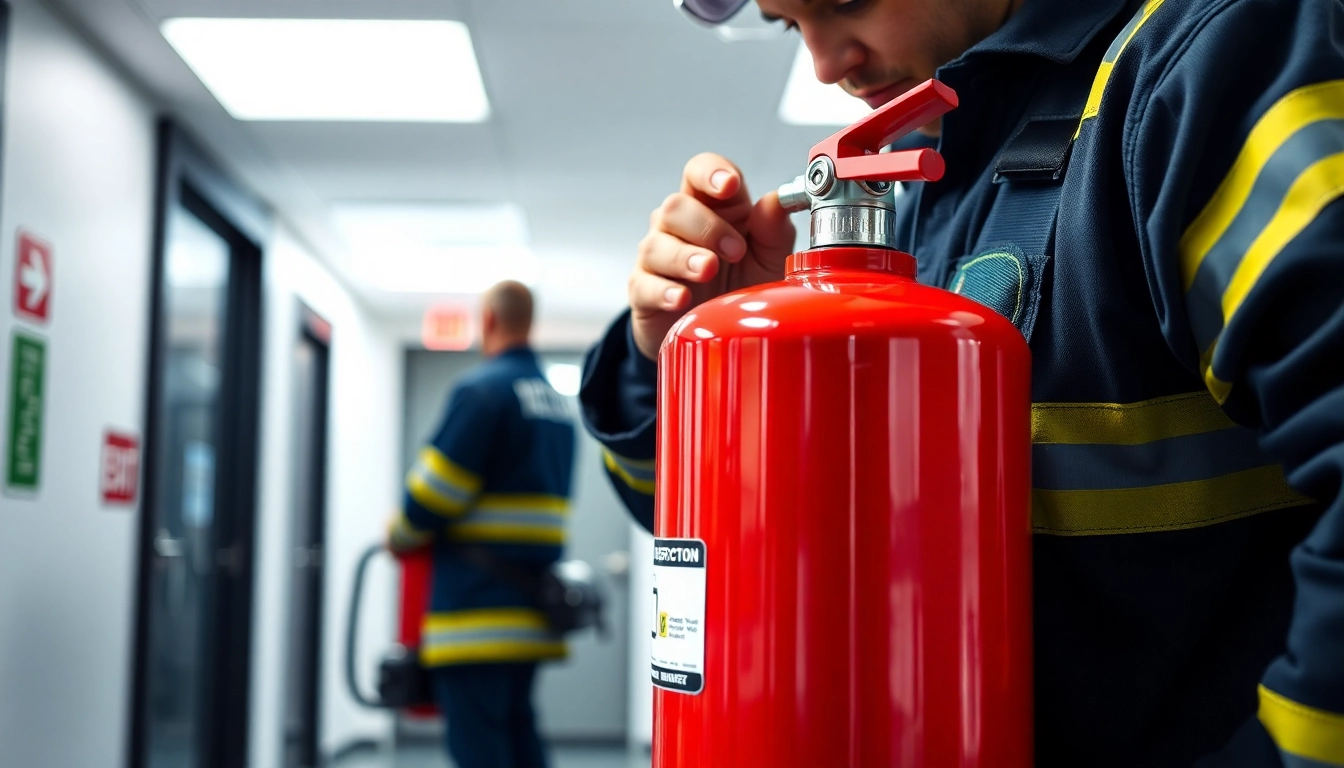Understanding the Importance of Fire Extinguisher Checks
Fire extinguishers serve as crucial life-saving devices in emergencies, making the need for regular checks paramount. These checks, often referred to as fire extinguisher checks, ensure that the devices are functional and easily accessible. Regular inspections can mean the difference between life and death in the event of a fire. Understanding what these checks entail and why they are necessary can empower both individual users and businesses to foster a safer environment.
What are Fire Extinguisher Checks?
Fire extinguisher checks refer to a series of inspections designed to ensure the proper functioning and reliability of fire extinguishers. These inspections are typically categorized into visual inspections, annual maintenance checks, and hydrostatic testing. Each of these inspections evaluates different aspects of the extinguisher’s condition and readiness.
For instance, visual inspections are performed monthly and include checking the physical condition of the extinguisher, ensuring that it is easily accessible, and confirming that the pressure gauge indicates an adequate level. Annual maintenance checks require a more comprehensive assessment, often performed by a qualified professional, who will check for proper operation and conduct any necessary repairs. Hydrostatic testing, which is required every 5 to 12 years depending on the type of extinguisher, tests the cylinder for integrity and ability to hold pressure without failure.
Why Regular Inspections Matter
Regular inspections of fire extinguishers can significantly impact safety in both residential and commercial settings. A fire can spread quickly, and having a functional extinguisher is critical for immediate response. Common reasons why regular inspections are important include:
- Identifying Issues Early: Regular checks help to identify issues such as leaks, damage, or corrosion before they become critical problems.
- Ensuring Compliance: Following local and national fire safety regulations, such as those outlined by NFPA 10, helps organizations avoid penalties and maintain operational permits.
- Enhancing Safety Awareness: Regular inspections can enhance overall fire safety awareness among employees and residents, ensuring they know the location and condition of extinguishers in case of an emergency.
Legal Requirements for Fire Extinguisher Checks
In the United States, various regulations dictate the requirements for fire extinguisher checks. NFPA 10 outlines that fire extinguishers must be inspected upon installation, followed by a monthly visual inspection and a more comprehensive annual inspection conducted by a certified technician. Furthermore, annual maintenance must be properly documented.
Local regulations might vary, emphasizing the need to stay informed about fire safety standards in your jurisdiction. Organizations that fail to comply with these regulations not only risk fines but also endanger lives by not ensuring fire safety preparedness.
When and How to Perform Fire Extinguisher Checks
Proper timing and execution of fire extinguisher checks are essential for maintaining their functionality. Understanding when and how to carry out these checks allows for a more effective fire safety strategy.
Frequency of Inspections: Monthly, Annual, and Beyond
The frequency of fire extinguisher inspections can generally be categorized as follows:
- Monthly Inspections: Fire extinguishers should be visually inspected once a month. This inspection should include checking the pressure gauge, ensuring the extinguisher is free from obstructions, and physically inspecting for any signs of damage or corrosion.
- Annual Inspections: Once a year, a certified technician should perform a more in-depth inspection. This includes checking the condition of the extinguisher’s components, replacing any non-functioning parts, and documenting the findings.
- Hydrostatic Testing: This test assesses the integrity of the extinguisher by checking its ability to hold pressure. Most extinguishers require hydrostatic testing every 5 to 12 years, depending on the type and manufacturer recommendations.
Steps for Conducting Effective Fire Extinguisher Checks
To conduct an effective fire extinguisher check, follow these detailed steps:
- Locate the Extinguisher: Ensure that the extinguisher is in a clear, accessible location and not obstructed by furniture or other items.
- Examine the Physical Condition: Look for any visible damage such as dents, rust, corrosion, or leakage. Ensure that the nozzle is clear and the safety pin is intact.
- Check the Pressure Gauge: Ensure that the needle points to the green zone, indicating sufficient pressure. If it is in the red zone, the extinguisher may need recharging.
- Inspect the Inspection Tag: Confirm that the inspection tag is current and that the extinguisher has not expired.
- Document Your Findings: Keep a log of inspections and actions taken for record-keeping and accountability.
Signs Indicating a Need for More Frequent Checks
In some cases, additional signs may suggest the need for more frequent checks beyond the monthly and annual requirements. These include:
- Visible wear or damage to the extinguisher.
- The extinguisher has been discharged, even if only partially.
- Environmental changes, such as moving the extinguisher to a different location or changes in temperature that could affect the extinguisher’s performance.
- Any incidents necessitating fire safety scrutiny, such as nearby fires or smoke.
Common Pitfalls in Fire Extinguisher Checks
While conducting fire extinguisher checks may seem straightforward, several common pitfalls can jeopardize safety and compliance.
Neglecting Visual Inspections
Failing to conduct monthly visual inspections can lead to undetected issues. Many businesses and homeowners overlook this critical step, assuming that if the extinguisher appears to be in place, it is functional. Regular visual inspections are quick and crucial for ensuring functionality.
Overlooking Maintenance and Testing Requirements
Another common mistake is failing to follow through with annual maintenance. Some individuals may believe that monthly inspections suffice. However, a thorough annual maintenance check by a certified technician is essential for confirming the extinguisher’s operational efficacy.
Understand Inspection Tags and Their Importance
Inspection tags are often overlooked yet serve as vital documentation of the extinguisher’s condition. These tags provide a record of all inspections and maintenance work performed on the extinguisher and indicate when future checks are due. Ignoring the information on the inspection tag can lead to non-compliance with fire safety regulations.
Choosing Professional Help for Fire Extinguisher Checks
While regular self-checks are important, there are instances when seeking professional assistance is beneficial. Engaging certified inspectors can enhance the safety and reliability of fire extinguishers.
Benefits of Hiring Certified Inspectors
Opting for professional fire extinguisher checks can yield numerous advantages:
- Expertise: Certified inspectors bring specialized knowledge and experience to identify issues that may not be apparent to untrained individuals.
- Comprehensive Inspections: Professionals ensure a detailed inspection covering all aspects, including internal components, that an average user might miss.
- Documentation: Certified services provide documentation for compliance, which can be critical during inspections by fire departments or insurance companies.
Finding a Reliable Fire Safety Service Provider
Finding a reputable fire safety service provider can be challenging. Here are some tips for selecting a reliable company:
- Seek Recommendations: Ask other businesses or friends for referrals to trustworthy fire safety service providers.
- Check Credentials: Ensure that the company is certified and complies with local and national fire safety regulations.
- Assess Experience: Look for companies with a solid track record and extensive experience in the industry.
- Read Reviews: Online reviews and testimonials can provide insight into the quality of the service provided.
Questions to Ask Before Hiring an Inspector
Before hiring a fire extinguisher inspection service, consider asking the following questions:
- What certifications do you hold?
- Can you provide references from previous clients?
- What does your inspection process entail?
- How do you document the findings of your inspections?
- What is your approach to follow-up services?
Resources for Fire Extinguisher Checks and Compliance
Accessing the right resources can bolster fire safety compliance and effectiveness in your inspections and maintenance of fire extinguishers.
Fire Safety Regulations and Standards
Remaining informed about fire safety regulations is key. Resources like the National Fire Protection Association (NFPA) provide detailed guidelines about the standards for fire extinguishers and their maintenance, ensuring compliance with laws that protect lives. Keeping abreast of local fire codes is also critical for ensuring safety.
Inspection Checklists and Tools
Utilizing checklists and tools can enhance the effectiveness of inspections. Consider creating a personalized inspection checklist that includes all necessary steps and documentation fields. This can streamline inspections and ensure nothing is overlooked.
Online Training for Fire Safety Practices
Online courses and training modules can provide valuable insights into fire safety best practices. Many organizations offer training sessions tailored for both individuals and businesses, enhancing the overall understanding and importance of fire safety.
In summation, regular checks and maintenance of fire extinguishers are not only legal requirements but crucial for ensuring personal safety and preparedness in emergency situations. By understanding the significance of these checks, planning inspections, avoiding common pitfalls, and leveraging professional help, both individuals and organizations can maintain a robust fire safety culture.



